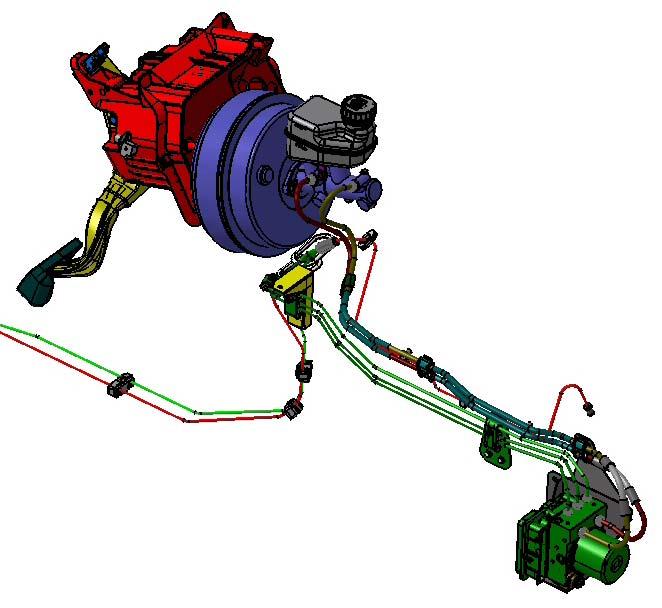
13 minute read
IntroductiontoMaserati
Parking
When parking the vehicle, shift the lever to the P position (park). A gear device inside the gearbox will lock the driving wheels.
WARNING: To prevent accidental engagement, the gearshift lever can onlybe shifted from P to any other position when the button on the gearshift lever and the brake pedal are depressed.
WARNING: Shift the lever to position P only when the vehicle is stationary.
WARNING: Before getting out of the vehicle, check that the automatic parking brake is engaged. Shift the gearshift lever to P even when you need to get out of the vehicle for only a few seconds leaving the engine running.
WARNING: If you turn off the engine with the gearshift lever in a position different from P, an acoustic signal will sound for a few seconds. If you open the driver’s door with the gearshift lever in a position different from P, an acoustic signal will sound for a few seconds.
Strategies for downhill driving
When the DRIVE mode is selected and the accelerator pedal is released, the gearbox system detects that the vehicle is moving downhill and deactivates upshifting. When the accelerator pedal is depressed, upshiftingis reactivated, however, with a delay of a few seconds.
When the brake pedal is depressed, the gearbox system downshiftsto provide enhanced engine braking power. In other words, when dr iving downhill, thegearbox system operates so as to avoid upshiftingand shifting gears when the accelerator pedal is released, and delays gear engagement by a few seconds when the accelerator pedal is depressed. In addition, when the brakes are applied, it engages the lowest gear in order to provide enhanced engine braking power. This strategy is aimed at making downhill driving safer.
Strategies in curves
The gearbox system detects when the vehicle is in a curve through the lateral acceleration and the steering angle. Detecting the DRIVE mode, the system deactivates both upshifting and downshifting until the vehicle comes out of the curve. In particularly tight uphill curves the system downshifts. Gearshiftingis reactivated when the vehicle comes out of the curve at a distance that varies depending on the vehicle speed.
Maserati GranTurismo
Hot-mode strategy
In the event that the engine oil or coolant temperature or both are too high, the gearbox system reduces the maximum engine speed to 4000 RPM. For this reason, upshiftingwill occur at this limit.
This strategy does not apply to downhill driving, so as to always have the efficiency of engine braking together with the standard braking system.
Acoustic signals
If you turn off the engine with the gearshift lever in a position different from P, an acoustic signal will sound for a few seconds.
If you open the driver’s door with the gearshift lever in a position different from P, an acoustic signal will sound for a few seconds.
With the lever in R, the system emits an acoustic signal for a few seconds to warn anyone in the vicinity that you are about to reverse.
Gearshift lever release in emergency conditions
In the event of failure of the electrical power supply system with resulting dead battery, the vehicle may only be moved after the gearshift lever has been released from the P position and moved to the N position. When there is no power, the lever can only be released using the emergency procedure.
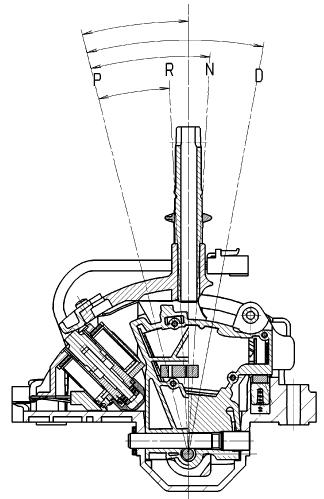
•Remove the cover G in front of the gearshift lever.
•Using the screwdriver contained in the toolkit, push on the release mechanism working through the hole and at the same time shift the gearshift lever to N.
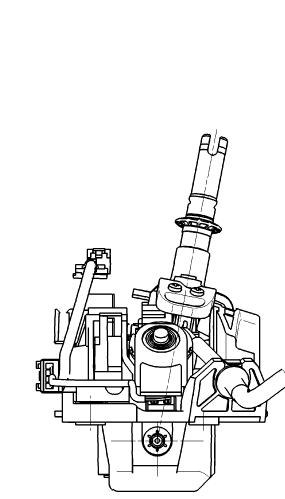
•The gearshift lever has now been released.
NOTE: In order to tow the vehicle, the emergency release procedure of the EPB system must be performed.
Low gearbox oil level
The red icon indicates that the gearbox oil level is too low. Ifthe warning light comes on, stop the vehicle. The gearbox oil level must be checked. Note: the gearbox does not contain an oil level sensor or switch. The gearbox oil level is a calculated estimation made by the electronic control unit.
Automatic gearbox failure
Depending on the different related messages, the symbol may indicate:
-a gearbox failure (error code stored)
-a too high actual temperature of the gearbox oil (no error code)
Gearbox failure
This message, highlighted in red, indicates a gearbox system failure, therefore, if you are travelling, the ECU that controls the device sets an emergency program. In these conditions, we recommended that you stop the vehicle and turn off the engine for at least one minute. When restarting the engine, the autodiagnosticsystem may cancel the malfunction, which will in any case be recorded by the ECU.
In failure conditions, the gearshift lever can always be shiftedto R, N, D and P. When shifting to the latter position, only a few gears will be available, depending on the malfunction found.
4. BrakingSystem
System components
•Brake servo 8+9“Ø
•Tandem brake master cylinder 15/16" Stroke 18+18mm
•Servo control ratio 13.5
•Self-ventilated front discs 330x32mm
•Self-ventilated rear discs 330x28mm with new brake calipers
•Parking brake with electric activation
•ABS/ESP Bosch 8.0
The Brembobraking system of the Maserati GranTurismois equipped with 4 ventilated discs on the front and rear wheels (front 330 mm Øx 32 mm, rear 330 mm Øx 28 mm) with 4-piston calipers.
Brake performance:
Stopping distance: from 100 to km/h: 35 m
Maximum deceleration: 1.24 g
From a safety point of view, the vehicle is equipped with ABS, which prevents the wheels from locking during braking, and EBD, which provides optimal brake force distribution between the front and the rear; both are integrated in the MSP system (Maserati Stability Program). MSP contains further electronic stability control (ESP), traction control (ASR) and engine brake torque control (MSR).
To help the driver during uphill starting, the Maserati GranTurismois fitted with the “Hill Holder”device which, in the case of sloped roads, immobilises the vehicle for a few seconds to allow the driver to move his foot from the brake pedal to the accelerator pedal without the vehicle rolling back.
The standard brake calipershave black finishing; on request, they can be supplied in five different colours: red, yellow, titanium, blue and silver. The Maserati name is black (for the red, yellow and silver calipers), white (for the black and blue calipers) and red (for the titanium calipers).
Maserati GranTurismo
Electric Parking Brake (EPB)
The Maserati GranTurismoisstandard fittedwithanelectricparking brake(EPB). The system isidenticaltothe one usedin the Quattroporte Automatic.
The EPB system is composed of:
• EPB actuator (cable puller) with integrated ECU
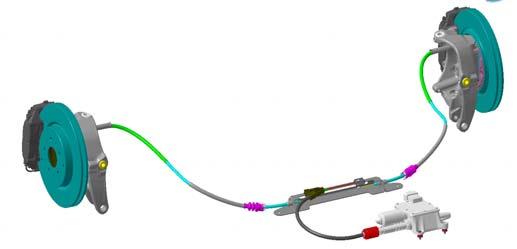
• Primary cable
• Equalizer / divider
• Secondary cables (LH + RH)
• Drum parking brakes, integrated in the rear brake discs.
• Parking brake command switch
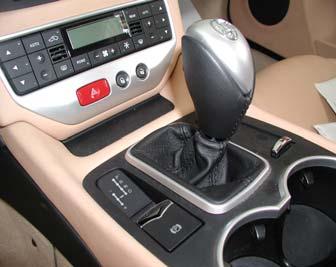

•“Park off” button
• Emergency release tool (integrated in the toolkit)
System operationand variousfunctionsare identicaltothe Quattroporte Automatic system. SeeQuattroporte formore details.
Note: Al GranTurismovehiclesare fittedwiththe PRE RELEASE function.
Maserati StabilityProgramm(MSP)
The Maserati QuattroporteAutomatic has a new stability control system integrated in the Bosch ESP 8 ECU. The dynamic performance of the Maserati GranTurismois supported by the Maserati Stability Program (MSP), specifically developed by the Trident engineers to provide greater safety and optimise the dynamic performance of the vehicle. The system is based on a set of sensors capable of detecting any vehicle failure with respect to ideal dynamic performance. It acts on the brakes and engine to stabilise their setup and restore proper performance. The Maserati Stability Program (MSP)performs the following functions:
− if the system detects a tendency to side skidding, it reduces the torque; it activates the brakes and stabilises the vehicle in just a few milliseconds (ESP);
− it prevents the wheels from locking during braking (ABS);


− it distributes the brake force between the front and rear axle,preventing the rear wheels from locking (EBD); it prevents slipping of the driving wheels, improving traction in low-grip conditions (ASR);
SPORT mode
Also for what concerns the MSP, the driver can choose Sport mode: in normal conditions, the system acts both on the engine torque and the brakes; when the SPORT button is pressed, the stability program is less "invasive" and permits enhanced racingstyle driving without however affecting safety. In fact, the operating threshold is raised and the system mainly operates on the brakes without cutting power to the engine.
MSP OFF mode
Pressing the “MSP OFF”button you can deactivate all the driving control systems (ESP, MSR and ASR), leaving only the ABS and EBD systems active. In emergency conditions, depress the brake pedal to reactivate all the driving control functions. If The vehicle will perform without any safety system and the driver will have to rely only on the vehicle and his driving skills for particularly exciting driving. Of course, it is advisable to use the “MSP OFF”mode only on dry roads and on tracks closed to traffic. Even if the control system is deactivated, the Anti-LockBraking System (ABS) will remain active to prevent wheel locking or skidding. In order to prevent unstable driving conditions, the MSP system may request the gearbox system to disable automatic gearshifting. This request is processed by the system which, depending on the gear engaged and the engine RPM, will evaluate the appropriate gearshift or temporarily deactivate this feature.
ICEmode
This mode can be used on particularly slippery road surfaces (e.g., snow, ice) and it is activated/deactivated by pressing the button on the NIT. The word ICE will illuminate on the instrument panel display. In “Low-grip" mode the system uses 2nd instead of 1st gear. This means that when you start from a stationary position with the engine running -both in automatic mode (gearshift lever in D) and manual mode (gearshift lever in M) -the vehicle will start in 2nd gear. When sequential manual mode is selected with 2nd gear engaged, a downshift request will be ignored.

When sequential manual mode is selected with 2nd gear engaged, a downshift request will be ignored. While driving, the system automatically switches to the upper gear if the engine reaches the pre-established speed rate (3,000 RPM). “Low-grip" mode has priority over SPORT mode and assists the MSP system. If “ICE”mode is activated when “SPORT”mode is active, during the transition stage it may happen that both the “ICE”and the “SPORT” messages are present on the CAN line. In this case, the system will give priority to the “ICE”message, immediately showing it on the display.
5. DrivingControls
The standard steering column has manual adjustment for height and depth. Instead of the steering column with manual adjustment, you can request the version with electrical adjustment in combination with the comfort pack for the seats (this includes storage of the settings and heating).
The steering rack (TRW) and vehicle speed sensitive power steering are similar to the one used in the Quattroporte. The steering ratio has been changed with respect to the Quattroporte(more direct) to offer a more dynamic vehicle control. Steering diameter (from pavement to pavement): 10.7 m
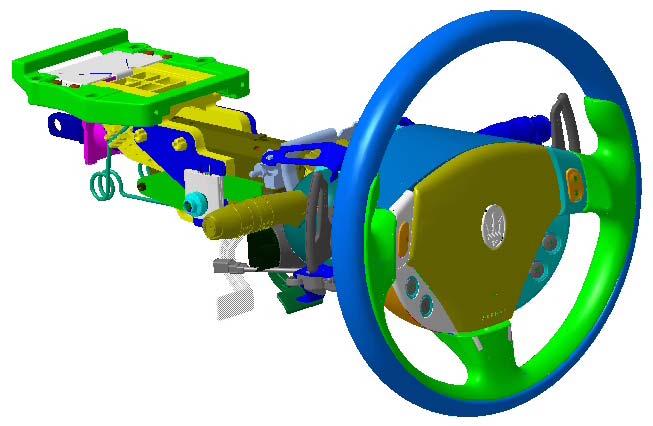
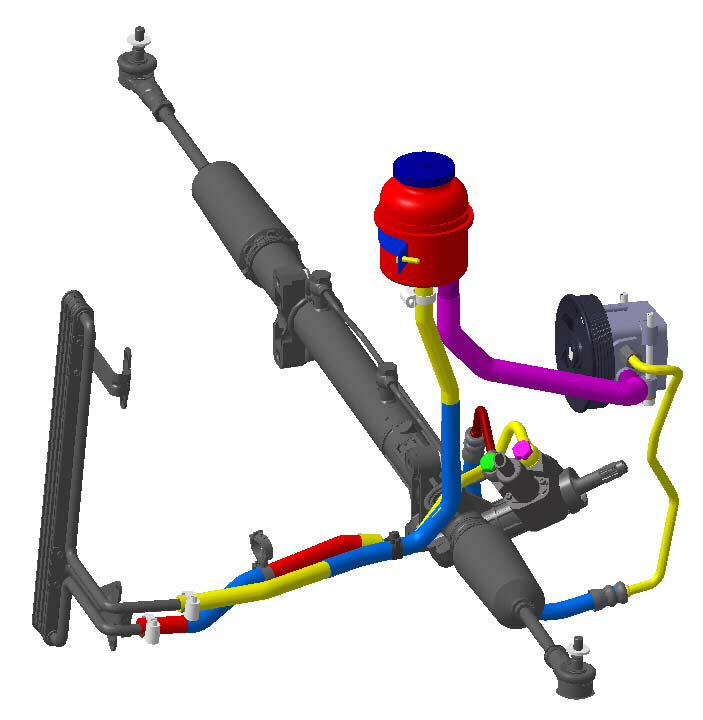
Maserati GranTurismo
6. Suspensionsand Wheels Wheels

In the standard configuration, the Maserati GranTurismois equipped with 19”aluminium wheel rims with different-sized front and rear tyres: for better power discharge to the ground, the rear tyres have a wider tread than the front ones. The 19”wheel rims are in light alloy; front 8.5J x 19, profile H2; rear 10.5J x 19, profile H2; Front tyres 245/40 R19, rear tyres 285/40 R19.
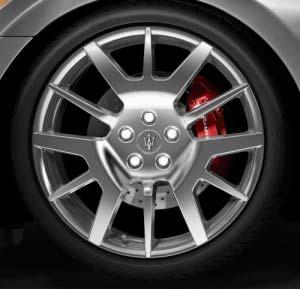
A racing-style 20”version is available, which, although slightly reducing comfort, increases handling and response to steering movements, thanks to the effect of the smaller drift angle. The look is inspired by that of the Birdcage 75°wheels and further underlines the power of its mechanics.
Optional: 20" light alloy wheel rims; front 8.5J x 20, profile H2; rear 10.5J x 20, profile H2; Front tyres 245/35 R20, rear tyres 285/35 R20.
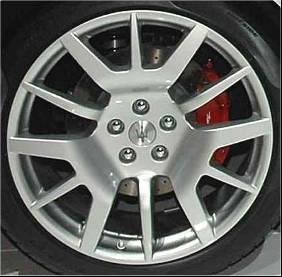
Both types are available with Ball-Polished treatment and in mercury grey:
The ball-polished treatment emphasises the mechanical features at the same time gives a brilliant effect even if not as eye-catching as the chrome-plated wheels.
− The dark mercury grey further highlights the racing-like character of the GranTurismo.
IntroductiontoMaserati
Tyre pressure monitoring system (optional)
TRIP button : displays the “Tyre pressure”information for 10 seconds
Information displayed :
-System temporarily inactive (for example: external radio interference)
-System not calibrated (for example: a tyre has been replaced )
-System failure
-System not active (if it is disabled by the diagnostic system)
-Low pressure or puncture of the LH front, RH front, LH rear and RH rear tyres
-Low pressure or puncture in unidentified tyre
Note: If the system is not calibrated (for example: a tyre has been replaced) calibrate the system by pressing the button on the front ceiling light (from 4 to 10 sec.). The completion of the calibration procedure is indicated on the instrument panel.
System calibration
After replacing or inflating one or more tyres, the system must be calibrated once again. To calibrate the system, press and hold button A, located on the inside roof, for a time ranging between 4 and 10 seconds. The system takes a maximum of 20 minutes to complete the calibration procedure with the vehicle in motion. Agreen symbol will appear on the display together with the message "Calibration started”. If the user recalls the information page showing the pressure levels of each tyre, dashes “–.–”will be viewed in the place of the values.
You can access the information screen page that shows the pressure values of each tyre by repeatedly pressing the “Mode”button B
Maserati GranTurismo
Suspensions
The chassis of the Maserati GranTurismois fitted with overlapping-triangle front and rear suspension with forged aluminium hub carrier and arms, with the aim of reducing the unsprungweights of the vehicle.
As an optional, the Maserati GranTurismocan come equipped with aluminium gas shock absorbers with Skyhook system for automatic and continuous damping adjustment. This technology is used to assure optimal comfort levels with any road condition, without affecting performance and the racing-style character of the vehicle.
The Skyhook system acts by means of acceleration sensors which record the movements of each wheel and the bodywork. The ECU processes the information received, analyses the driving style and the road conditions and immediately adjusts the shock absorbers by acting on the proportional valve of each of them.
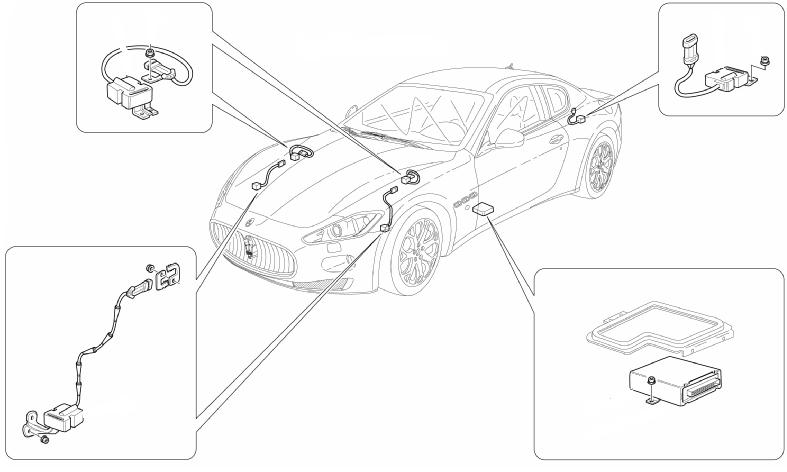
In the case of the fixed calibration system, the suspension set-up is optimised for handling:
•The standard suspension has been designed for those customers who prefer good handling over driving comfort.
•The standard suspension provides a vehicle set-up which is quite similar to that used with the Skyhook system in Sport mode.
•The Skyhook suspension offers superior driving comfort with respect to the standard suspension.
Skyhooklayout
IntroductiontoMaserati
Front suspensions
Maserati GranTurismo
•Articulated quadrilateral independent wheel suspension with double oscillating triangle
•Anti-dive and anti-squad geometry
•Forged aluminium levers, aluminium hub carrier
•25 mm øarticulated stabilizer bar on ball joints
•Optional Skyhook variable-damping aluminium hydraulic shock absorbers
•Suspension mounted on a new separate frame rigidly connected to the bodywork
Rearsuspensions
•Articulated quadrilateral rear independent wheel suspension with double oscillating triangle

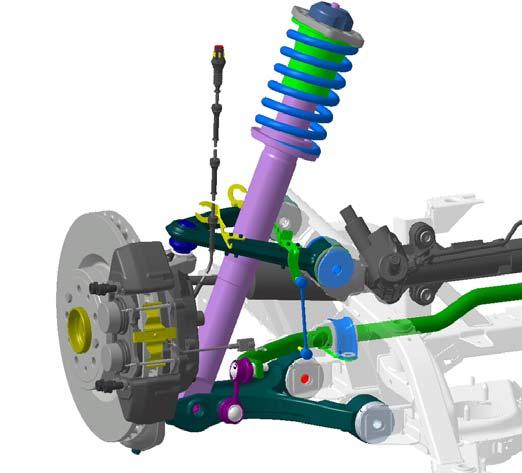
•Anti-dive and anti-squat geometry
•Forged aluminium levers, aluminium hub carrier
•24 mm øarticulated stabilizer bar
•on ball joints
•Optional Skyhook variable-damping aluminium hydraulic shock absorbers
•Suspension mounted on a new separate frame rigidly connected to the bodywork
IntroductiontoMaserati
Wheel alignment
Front Camber : -0.30°±0°10’on each wheel
Caster : 3.30°±0°10’on each wheel
Total toe-in: -2,1 ±0.4mm (1,05 mm opening on each wheel)
Rear Camber :-1.30°±0°10’on each wheel
Total toe-in: 4.2 ±0.4mm(2,1 mm closing on each wheel)
Caution Caution
Maserati GranTurismo
The characteristic angles must be adjusted during “static load” configuration, that is, with all the fluid tanks filled, the fuel tank full (90 litres) and 75 kg on both front seats.
7. Safety components
The vehicle is equipped with 6 airbags (2 front and 4 lateral ones) and electronicallyoperated pretensionersfor all of the seat belts.
The system components are the following:
1) Electronic control unit
2) Passenger's front airbag
3) Air bag deactivation switch passenger's side
4) Passenger's front seat belt pretensioner
5)Passenger's side bag
6) Satellite crash sensor on passenger side
7) Passenger-side door-mounted airbag
8) Driver-side door-mounted airbag
9) Driver's side bag
10) Satellite collision sensor on driver side

11) Passenger's front seat belt pretensioner
12) Airbag system failure warning light
13) Passenger’s airbag deactivation warning light
14) Driver's front airbag
15) Clock Spring
16) Diagnostics socket
17) Rear left-hand pretensioner
18) Rear right-hand pretensioner
19) Front left-hand Crash Zone pretensioner
20) Front left-hand Crash Zone Sensor.
IntroductiontoMaserati
If replacing the NAB or a component of the airbag system, the initialisation procedure must be performed on the new component. To perform the initialisation procedure, detach the electrical connectors for the driver's airbag, passenger's airbag and side bags positioned under the front seats.
Caution
Follow the instructions and relative safety regulations for removal and storage of the airbag modules.
Connect the SD3 diagnostics tester to the NBC diagnostic socket.
Access "CYCLE ENVIRONMENT", select the airbag node configurationcycle and continue. After entering the vehicle data, select "CONTINUE" andturn the key to ON.
Wait for the checks to be completed and then follow the guided procedure, by means of which the tester will check the information available in the ECU.
Continue with the cycle until the tester prompts you to connect the driver-side airbag connectors, but without fitting the two secondary locks (safety devices for the connectors). Connect the two secondary locks, first connecting the yellow oneand then the green one. Subsequently, the page "ATTACH THE CONNECTOR THAT KEEPS THE PASSENGER
AIRBAG LINE 1 IN SHORT-CIRCUIT" will be displayed
The part number of the fake connector is 900027450. This can be ordered from the Maserati Spare Parts Department. Connect the fake connector 900027450
Wait until the next screen pages prompt you to remove the fake connector 900027450 and to attach the passenger-side airbag connector. Attach the passenger-side airbag connector. Subsequently the screen page prompting you to attachthe sidebag connectors will be displayed. Connect the sidebagconnectors.
The diagnostic tester will then perform a check of the switches for the front and rear seat belts.
Buckle the seat belts in the following order:
-Front seat, driver's side
-Rear left-hand seat
-Rear seat, passenger's side
-Front seat, passenger's side
The buckled seat belts are displayed in red.
The diagnostic tester then asks the user if the manual deactivation device for the passenger-side airbag is fitted. Reply "yes" and continue with the cycle. Perform the requested operations to check that the manual airbagdeactivation device is properly functioning.
The diagnostic tester will then prompt you to check that the airbag warning light on the instrument panel is off. Subsequently, the summary of the initialisation cycle progress appears, which should be printed and filed. Refit all the components previously removed to access the electrical connections of the airbag system.
IntroductiontoMaserati
8. ElectricalSystemsand Devices
Electronic vehicle architecture

The electronic and electric functions of the various ECUsand nodes are controlled by the F.L.ORE.N.C.E system, a technology that Maserati introduced withthe Quattroporte. The use of this new system, designed for CAN communication, has allowed us to find immediate solutions as to communication, dimension, weight and cost problems. Each electronic control unit is positioned in the barycentre with respect to the functions it controls, so that the system is fully optimised.
The F.L.ORE.N.C.E. system is made up of two CAN communication networks:
• C-CAN network: dynamic control and management of the vehicle (high speed);
• B-CAN network: control of the standard bodywork functions (low speed).
The C-CAN and B-CAN networks are connected to each other by the body computer unit which is equipped with both the interfaces and hence performs the network GATEWAY function for transferring information.
The system also provides a number of serial lines used for diagnostics and other specific functions:
•K-line diagnostics for NCM / NFR / CSG / NCS / CAF
•Serial line w for immobilizer recovery
•A-BUS serial line for alarm, windscreen wiper and twilight sensor control.










